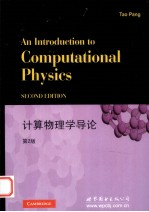

计算物理学导论PDF电子书下载
- 电子书积分:13 积分如何计算积分?
- 作 者:(美)庞涛著
- 出 版 社:上海:世界图书上海出版公司
- 出版年份:2011
- ISBN:9787510035203
- 页数:385 页
1 Introduction 1
1.1 Computation and science 1
1.2 The emergence of modern computers 4
1.3 Computer algorithms and languages 7
Exercises 14
2 Approximation of a function 16
2.1 Interpolation 16
2.2 Least-squares approximation 24
2.3 The Millikan experiment 27
2.4 Spline approximation 30
2.5 Random-number generators 37
Exercises 44
3 Numerical calculus 49
3.1 Numerical differentiation 49
3.2 Numerical integration 56
3.3 Roots of an equation 62
3.4 Extremes of a function 66
3.5 Classical scattering 70
Exercises 76
4 Ordinary differential equations 80
4.1 Initial-value problems 81
4.2 The Euler and Picard methods 81
4.3 Predictor-corrector methods 83
4.4 The Runge-Kutta method 88
4.5 Chaotic dynamics of a driven pendulum 90
4.6 Boundary-value and eigenvalue problems 94
4.7 The shooting method 96
4.8 Linear equations and the Sturm-Liouville problem 99
4.9 The one-dimensional Schrodinger equation 105
Exercises 115
5 Numerical methods for matrices 119
5.1 Matrices in physics 119
5.2 Basic matrix operations 123
5.3 Linear equation systems 125
5.4 Zeros and extremes of multivariable functions 133
5.5 Eigenvalue problems 138
5.6 The Faddeev-Leverrier method 147
5.7 Complex zeros of a polynomial 149
5.8 Electronic structures of atoms 153
5.9 The Lanczos algorithm and the many-body problem 156
5.10 Random matrices 158
Exercises 160
6 Spectral analysis 164
6.1 Fourier analysis and orthogonal functions 165
6.2 Discrete Fourier transform 166
6.3 Fast Fourier transform 169
6.4 Power spectrum of a driven pendulum 173
6.5 Fourier transform in higher dimensions 174
6.6 Wavelet analysis 175
6.7 Discrete wavelet transform 180
6.8 Special functions 187
6.9 Gaussian quadratures 191
Exercises 193
7 Partial differential equations 197
7.1 Partial differential equations in physics 197
7.2 Separation of variables 198
7.3 Discretization of the equation 204
7.4 The matrix method for difference equations 206
7.5 The relaxation method 209
7.6 Groundwater dynamics 213
7.7 Initial-value problems 216
7.8 Temperature field of a nuclear waste rod 219
Exercises 222
8 Molecular dynamics simulations 226
8.1 General behavior of a classical system 226
8.2 Basic methods for many-body systems 228
8.3 The Verlet algorithm 232
8.4 Structure of atomic clusters 236
8.5 The Gear predictor-corrector method 239
8.6 Constant pressure,temperature,and bond length 241
8.7 Structure and dynamics of real materials 246
8.8 Ab initio molecular dynamics 250
Exercises 254
9 Modeling continuous systems 256
9.1 Hydrodynamic equations 256
9.2 The basic finite element method 258
9.3 The Ritz variational method 262
9.4 Higher-dimensional systems 266
9.5 The finite element method for nonlinear equations 269
9.6 The particle-in-cell method 271
9.7 Hydrodynamics and magnetohydrodynamics 276
9.8 The lattice Boltzmann method 279
Exercises 282
10 Monte Carlo simulations 285
10.1 Sampling and integration 285
10.2 The Metropolis algorithm 287
10.3 Applications in statistical physics 292
10.4 Critical slowing down and block algorithms 297
10.5 Variational quantum Monte Carlo simulations 299
10.6 Green’s function Monte Carlo simulations 303
10.7 Two-dimensional electron gas 307
10.8 Path-integral Monte Carlo simulations 313
10.9 Quantum lattice models 315
Exercises 320
11 Genetic algorithm and programming 323
11.1 Basic elements of a genetic algorithm 324
11.2 The Thomson problem 332
11.3 Continuous genetic algorithm 335
11.4 Other applications 338
11.5 Genetic programming 342
Exercises 345
12 Numerical renormalization 347
12.1 The scaling concept 347
12.2 Renormalization transform 350
12.3 Critical phenomena:the Ising model 352
12.4 Renormalization with Monte Carlo simulation 355
12.5 Crossover:the Kondo problem 357
12.6 Quantum lattice renormalization 360
12.7 Density matrix renormalization 364
Exercises 367
References 369
Index 381
- 《计算机网络与通信基础》谢雨飞,田启川编著 2019
- 《大学计算机实验指导及习题解答》曹成志,宋长龙 2019
- 《计算机辅助平面设计》吴轶博主编 2019
- 《计算机组成原理解题参考 第7版》张基温 2017
- 《云计算节能与资源调度》彭俊杰主编 2019
- 《新编高中物理竞赛教程习题全解》钟小平主编;钟小平,倪国富,曹海奇编写 2019
- 《物联网导论》张翼英主编 2020
- 《数学物理方法与仿真 第3版》杨华军 2020
- 《Helmholtz方程的步进计算方法研究》李鹏著 2019
- 《材料导论》张会主编 2019
- 《SQL与关系数据库理论》(美)戴特(C.J.Date) 2019
- 《魔法销售台词》(美)埃尔默·惠勒著 2019
- 《看漫画学钢琴 技巧 3》高宁译;(日)川崎美雪 2019
- 《优势谈判 15周年经典版》(美)罗杰·道森 2018
- 《社会学与人类生活 社会问题解析 第11版》(美)James M. Henslin(詹姆斯·M. 汉斯林) 2019
- 《海明威书信集:1917-1961 下》(美)海明威(Ernest Hemingway)著;潘小松译 2019
- 《迁徙 默温自选诗集 上》(美)W.S.默温著;伽禾译 2020
- 《上帝的孤独者 下 托马斯·沃尔夫短篇小说集》(美)托马斯·沃尔夫著;刘积源译 2017
- 《巴黎永远没个完》(美)海明威著 2017
- 《剑桥国际英语写作教程 段落写作》(美)吉尔·辛格尔顿(Jill Shingleton)编著 2019
- 《TED说话的力量 世界优秀演讲者的口才秘诀》(坦桑)阿卡什·P.卡里亚著 2019
- 《小手画出大世界 恐龙世界》登亚编绘 2008
- 《近代世界史文献丛编 19》王强主编 2017
- 《课堂上听不到的历史传奇 世界政治军事名人 初中版》顾跃忠等编著 2015
- 《365奇趣英语乐园 世界民间故事》爱思得图书国际企业 2018
- 《近代世界史文献丛编 36》王强主编 2017
- 《近代世界史文献丛编 11》王强主编 2017
- 《近代世界史文献丛编 18》王强主编 2017
- 《乐队伴奏长笛世界名曲集 4》芭芭拉·哈斯勒-哈瑟 2017
- 《世界名著阅读经典 欧也妮·葛朗台 高老头 全译本 12-16岁》(法)巴尔扎克著 2017
